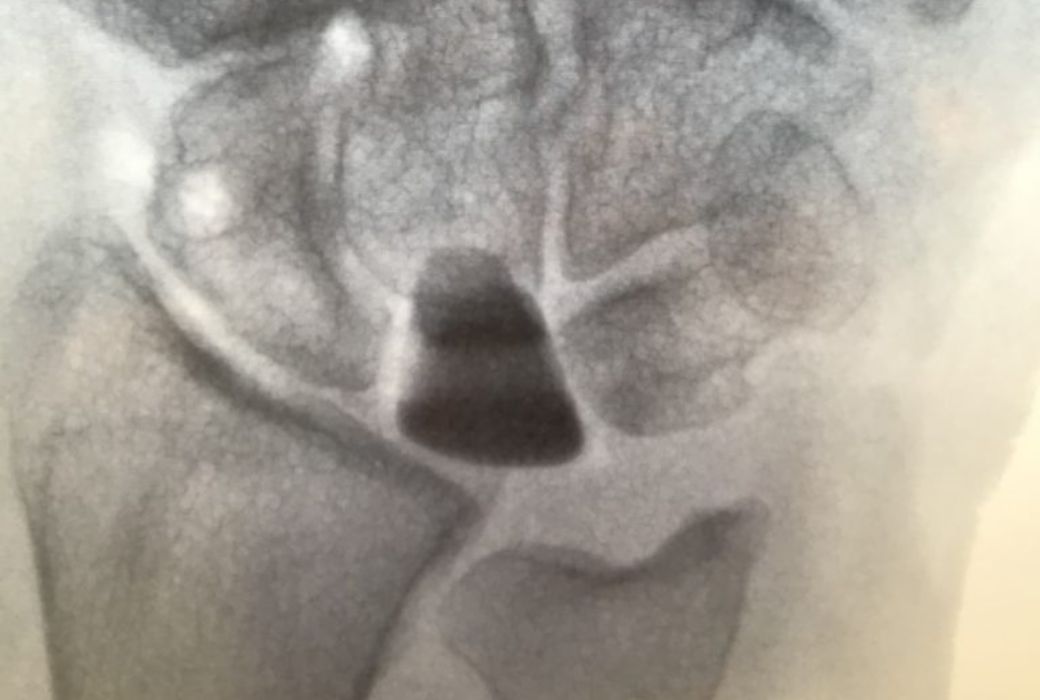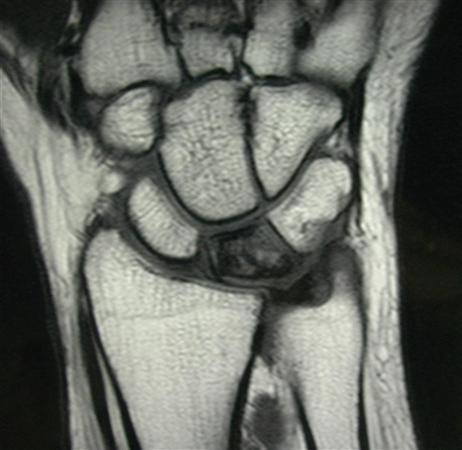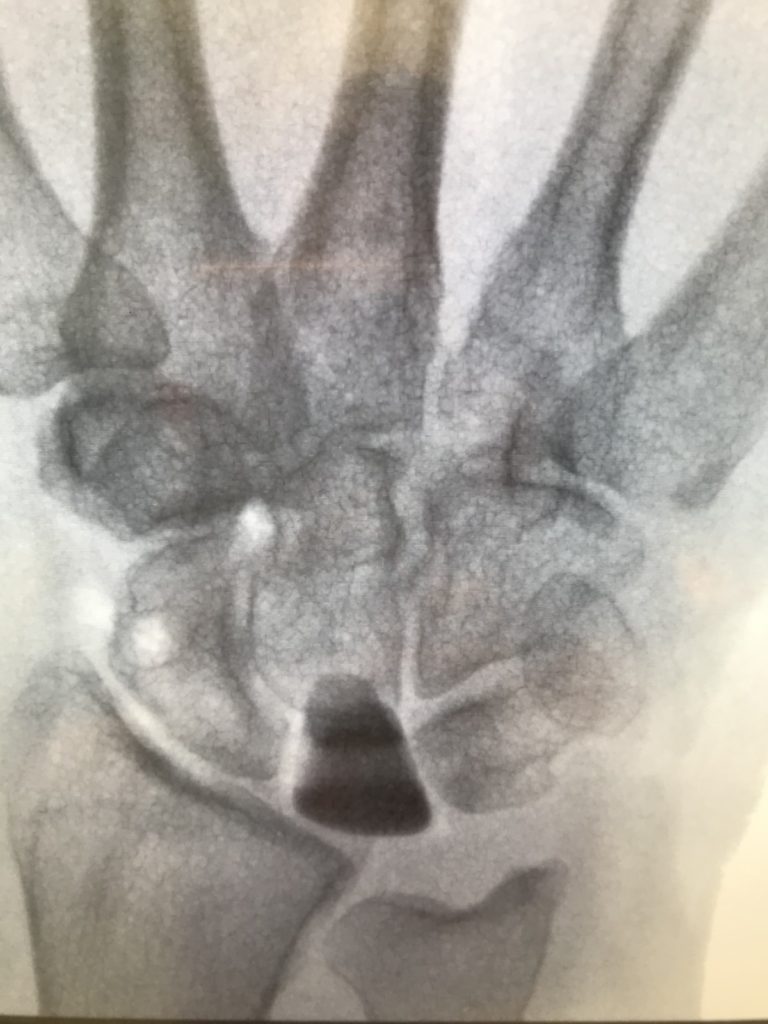
Kienbock’s Disease – Lunate Bone Avascular Necrosis and Treatment Options
Book AppointmentKienböck’s disease affects many people, some of whom may not even realise it. It is in essence the loss of blood flow to the lunate bone in the wrist, causing it to die and break apart. In the long term, this damage can lead to arthritis in other parts of the wrist.

Causes of Kienböck’s Disease
The exact cause of Kienböck’s disease varies as there is no evidence to suggest it is inherited. There are multiple factors known to exacerbate the condition, these include:
- Skeletal variations: Where the bones in the wrist may have grown in an abnormal manner, putting pressure on the lunate.
- Blood flow conditions: Having a pre-existing condition like Lupus or Sickle Cell Anaemia.
- Trauma: Even a single blow to the wrist can cause significant damage and worsen the condition. Alternatively, repeated wrist motions that put pressure on the lunate can over time become equivalent to a single heavy impact.
Signs and Symptoms of Kienböck’s Disease
Kienböck’s disease is a subtle and slow-developing condition that may not present obvious symptoms at first and causes many people to only seek medical advice when in the later stages. It is important therefore to be aware of the warning signs that may present themselves over time.
Motion and Strength
In the early stages, Kienböck’s disease may not present with outright pain but instead with a loss of motion and strength. If you feel stiffness and a decrease in the motion of your wrist, most obviously whilst trying to turn the hand upward, then this may be a warning of a deeper condition. You may also be experiencing a loss in the strength of your grip making it harder to hold onto smaller items. You may also notice a clicking/clunking sound coming from your wrist during movement. If you are experiencing these symptoms, especially after a remarkable impact, it is important to seek medical advice.
Pain and Swelling
As the condition progresses you may begin to experience more pressing symptoms. These indicators are far more noticeable especially when they’re combined with the aforementioned motion indicators. Sufferers of Kienböck’s will often complain of pain in the wrist, accompanied by swelling. A key warning sign would be a combination of the above, with pain or tenderness directly above the lunate bone.

The Development Process
Early Stages
When the disease first manifests, it can be difficult to diagnose, as this relies heavily on the sufferer to seek medical advice, and to have targeting scans. At first, the lunate loses its blood supply causing stiffness and leading to pain and swelling. The bone will appear normal on an x-ray, but may show signs of the disease on an MRI scan.
Mid Stages
This is when the condition starts to cause the sufferer prolonged discomfort. The lunate has lost its blood supply, causing it to harden and become highly vulnerable to fracture. This development does mean that the changes to the density of the bone can be seen on an x-ray, leading to a more likely diagnosis.
Late Stage
At first, the lunate will fracture and begin to collapse, and once this has happened the fragments will cause lasting damage to the nearby bones and will contribute to severe arthritis. If left undiagnosed up to this point the damage will be much harder if not impossible to correct. Not all sufferers reach this stage of the disease, but it is still vitally important that it is diagnosed and treated before reaching this stage.

Diagnosis
People often ignore their symptoms for years, as they see them as so minor that they can’t be important. This is a common reason that the condition often goes unnoticed. It is also difficult for doctors to diagnose the disease, as in its early stages it wouldn’t present on an x-ray and would need a targeted MRI to discover it.
This means that to discover it the doctor will have to ask questions surrounding any symptoms you may be experiencing, a history of your medical conditions (especially anything concerning a blood flow disorder) and a history of any trauma your wrist may have sustained.
In later stages, the condition could be picked up on an x-ray or when the patient has fractured their lunate and is suffering from the accompanying pain. A detailed CT scan would be helpful to determine the exact number and position of the lunate fragments that are causing issues in the wrist.
Kienböck’s Disease Treatments
Revascularization
This process involves restoring the blood flow directly to the lunate bone. During the wrist surgery, the surgeon will remove a healthy portion of another bone, with its blood vessels intact, and place it directly into the lunate. This procedure may require the use of an external fixator for some time afterwards, which is a metal device worn on the outside of the wrist, supporting the lunate via a series of pins which are inserted into the bone. Revascularization is only possible while the lunate bone is still intact, and so is an early stage option.
Proximal Row Carpectomy
A proximal row carpectomy (PRC) may be necessary if a patient is in the later stages of the disease, with the lunate bone having already shattered. A PRC involves removing the fragments of the lunate, along with the two bones on either side of it. This may be used in part with Implant Arthroplasty.
Implant Arthroplasty
This new procedure sees the removal of the lunate bone and replacement with a pyrolytic carbon material prosthetic. This procedure makes the removal of other bones in the wrist unnecessary and so preserves the patient’s natural anatomy.
Fusion
This method is mainly focussed on targeting pain in patients in the later stages of the disease. It involves fusing either some or all of the bones in a patient’s wrist, essentially creating one large bone. This procedure comes at the cost of wrist mobility, but can largely eliminate the pain felt by the sufferer. When full fusion is employed, the patient retains the ability to rotate their forearm. This is potentially the most drastic procedure as it will permanently alter the patient’s anatomy. If you’re in need of wrist support, make sure to get in touch with your surgeon.
Joint Levelling
If a patient has developed Kienböck’s disease through skeletal variations, then it is likely that they will receive this treatment. It involves either shortening or lengthening the radius and ulna bones where appropriate to relieve the pressure on the lunate bone, targeting the disease at its cause.
Frequently Asked Questions About Kienbock’s Disease
What are the stages of Kienbock's disease?
Kienbock’s disease (also known as lunate necrosis or avascular necrosis of the lunate) progresses through three distinct stages:
Early Stage (Stage I-II) The lunate bone loses blood supply, causing wrist stiffness, pain, and swelling. At this stage, X-rays appear normal, but MRI scans can detect early bone death. Patients may experience decreased grip strength and reduced wrist mobility.
Mid Stage (Stage III) The lunate bone hardens and becomes dense due to lack of blood flow, making it vulnerable to fracture. Changes become visible on X-ray imaging. Patients typically experience increased pain and significant loss of wrist function.
Late Stage (Stage IV) The lunate bone collapses and fragments, causing permanent damage to surrounding carpal bones. This leads to severe wrist arthritis, chronic pain, and substantial loss of wrist mobility.
Early diagnosis and treatment are crucial to prevent progression to late-stage disease.
Is Kienbock's disease curable?
Kienbock’s disease treatment outcomes depend heavily on the stage at diagnosis. In early stages, surgical procedures like revascularization can restore blood flow to the lunate bone and potentially halt disease progression, offering the best chance for preserving natural wrist function.
However, Kienbock’s disease is not fully curable once significant bone damage occurs. Mid to late-stage treatments focus on pain management, preventing arthritis progression, and maintaining wrist function through procedures such as:
- Proximal row carpectomy
- Implant arthroplasty
- Wrist fusion
The key to optimal outcomes is early detection – patients experiencing unexplained wrist pain, stiffness, or decreased grip strength should seek evaluation from a hand and wrist specialist. Without treatment, Kienbock’s disease invariably progresses to severe wrist arthritis and permanent disability.
Can Kienbock's disease be treated without surgery?
Kienbock’s disease almost always requires surgical treatment to prevent progression and preserve wrist function. Non-surgical management with immobilization, pain medication, or activity modification cannot restore blood flow to the lunate bone or reverse bone damage.
Surgical treatment options vary based on disease stage and include:
- Revascularization (early stage) – transplanting bone with intact blood vessels to restore circulation to the lunate
- Joint leveling procedures – adjusting the radius and ulna bones to reduce pressure on the lunate
- Proximal row carpectomy – removing damaged bone fragments in advanced cases
- Implant arthroplasty – replacing the lunate with a pyrolytic carbon prosthetic
- Wrist fusion – joining wrist bones to eliminate pain while sacrificing some mobility
Your hand surgeon will recommend the most appropriate surgical approach based on your disease stage, wrist anatomy, activity level, and treatment goals. Early surgical intervention offers better functional outcomes and may preserve natural wrist motion.
What causes Kienbock's disease?
The exact cause of Kienbock’s disease remains unclear, but several risk factors contribute to lunate bone death:
Skeletal variations – abnormal wrist bone anatomy, particularly when the ulna is shorter than the radius (negative ulnar variance), increases pressure on the lunate bone.
Vascular conditions – disorders affecting blood circulation such as lupus, sickle cell disease, or other conditions that compromise blood vessel function can reduce blood flow to the lunate.
Trauma – both acute wrist injuries (fractures, sprains, or direct impact) and repetitive stress from occupations or activities involving repeated wrist motions can damage blood vessels supplying the lunate.
Kienbock’s disease is not inherited or contagious. It typically affects adults between 20-40 years old and occurs more frequently in men. The disease usually affects only one wrist.
What are the early warning signs of Kienbock's disease?
Early symptoms of Kienbock’s disease are often subtle, causing many patients to delay seeking treatment. Common early warning signs include:
- Wrist stiffness and reduced range of motion, especially when turning the hand upward
- Decreased grip strength making it difficult to hold small objects
- Pain and tenderness over the lunate bone (center of the wrist)
- Wrist swelling that may come and go
- Clicking, clunking, or popping sounds during wrist movement
- Gradual onset of symptoms that worsen over time
These symptoms may initially be dismissed as a simple wrist sprain or repetitive strain injury. However, if you experience persistent wrist pain or stiffness lasting more than a few weeks, especially following wrist trauma, consult a hand and wrist specialist.
Early diagnosis through MRI imaging can detect Kienbock’s disease before irreversible bone damage occurs, significantly improving treatment outcomes.
How is Kienbock's disease diagnosed?
Diagnosing Kienbock’s disease requires a combination of clinical examination and imaging studies.
Physical examination – Your hand surgeon will assess wrist tenderness, range of motion, grip strength, and swelling. They’ll review your medical history, including any wrist injuries and blood circulation disorders.
Imaging tests include:
- X-rays – identify bone density changes, collapse, or fragmentation (though early-stage disease may not appear on X-rays)
- MRI scans – the most sensitive test for detecting early avascular necrosis before bone structural changes occur
- CT scans – evaluate the extent of bone fragmentation and collapse in advanced stages
Early diagnosis is challenging because initial symptoms mimic common wrist sprains, and the lunate appears normal on standard X-rays. If you have unexplained chronic wrist pain, request an MRI evaluation even if X-rays appear normal.
What happens if Kienbock's disease is left untreated?
Untreated Kienbock’s disease follows a progressive course leading to severe wrist disability. Without intervention, the lunate bone continues to deteriorate due to lack of blood supply.
Progressive complications include:
- Severe degenerative arthritis throughout the wrist joint
- Chronic, debilitating wrist pain that interferes with daily activities
- Significant loss of wrist motion and flexibility
- Marked decrease in grip strength
- Visible wrist deformity
- Permanent disability affecting work and quality of life
At advanced stages, treatment options become limited and may require extensive surgery such as wrist fusion, which permanently eliminates wrist motion. This underscores the critical importance of early diagnosis and treatment.
If you suspect Kienbock’s disease, seek evaluation from a specialist in hand and wrist surgery promptly.
Sound familiar? Get in touch
Please use this form if you are interested in booking an appointment. We do not give general medical advice over email.
